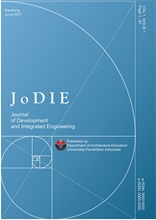ARCHITECTURE STUDIO SPACE ANALYSIS OF ENGINEERING FACULTY, SUBANG UNIVERSITY
Abstract
The Architectural Design Studio Room, Faculty of Engineering, University of Subang is a room with a large intensity of use, the core activities of the studio start from carrying out the design planning process, making design concepts such as drawing concept sketches, then making pre-design drawings and detailed drawings to make design presentations such as mock-ups and poster. architectural design studio space design needs to accommodate the various activities it contains. Today, many students prefer to work on this course elsewhere rather than in the studio. As a result, the use of studios becomes less effective and has an impact on the condition of the studio which is empty of students. The use of the studio is greatly influenced by the quality of the studio space itself, starting from architectural components such as lighting, ventilation, and the carrying capacity of the furniture as well as the condition of the interior wall color of the studio space. The quality of this space can be seen from the level of student attendance, and the intensity of students being in the studio. This critique aims to find out how much influence the quality of space has on the effectiveness of space use, in this case, the design studio space in the architecture department. and it is hoped that the process of making changes or adding facilities that are able to accommodate all lecture activities and be able to provide lecture facilities that are comfortable and accommodate lecture activities. study program in the Department of Architecture. the carrying capacity of the furniture and the condition of the interior wall color of the studio space.
Keywords: Quality Standards, Subang University, Architectural Studio
Full Text:
PDFReferences
Akbardin, J., & Permana, A. Y. (2020). The Characteristics Study Of Parking User Behavior Toward Location Accessibility Of Non-Commercial Activities Center. International Journal of Advanced Science and Technology, 29(7), 3293–3300.
Bafadal, I. (2004). Management of School Supplies. Jakarta: The Literary Earth.
BSN. (2011). Draft Higher Education Facilities and Infrastructure Standards for Postgraduate and Professional Programs.
Crosby, PB (1997). Quality is free: The Art of Making Certain Quality,. New American Library.
Ernest, & Neufert, P. (1996). Architect Data Volume 3.
Hakiki, R., Aldy, P., & Hidayat, W. (2020). Sekolah Tinggi Migas Duri Dengan Penerapan Passive Cooling. Jurnal Arsitektur ZONASI, 3(3), 299–312. https://doi.org/10.17509/jaz.v3i3.26502
Ibrahim, M. L., & Ashadi, A. (2020). Kajian Konsep Arsitektur Semiotik Pada Bangunan Gedung Pertunjukan. Jurnal Arsitektur ZONASI, 3(3), 272–281. https://doi.org/10.17509/jaz.v3i3.25018
ISO-8402. (1994). Quality Management and Quality Assurance - Vocabulary.
Kadir, A. (2021). “Basics of Dynamic Web Programming Using PHP.” Andi Offset.
Kencanasari, R. . V., Surahman, U., Permana, A. Y., & Nugraha, H. D. (2020). Kondisi Kualitas Udara Di Dalam Ruangan Pemukimanan Non-Kumuh Kota Bandung. Jurnal Arsitektur ZONASI, 3(3), 235–245. https://doi.org/10.17509/jaz.v3i3.28134
Kotler, P. (1997). Marketing Management. In Indonesian Edition vol one. Prentice Hall.
Nadiar, F., Azmi, D., & Nusantara, D. (2019). ARSITEKTUR MEDITERANIA DI INDONESIA : ADAPTASI KEMEGAHAN DAN KINERJA TERMAL BANGUNAN DARI DAERAH MEDITERANIA DALAM MENGHADAPI PERUBAHAN IKLIM DI DAERAH TROPIS LEMBAB. Jurnal Arsitektur ZONASI, 2, 175–182.
Nurrahman, H. (2019). Optimalisasi Desain Fasad Bangunan Restaurant Di Kebonwaru, Batununggal Kota Bandung. Jurnal Arsitektur ZONASI, 2(2), 138. https://doi.org/10.17509/jaz.v2i2.17470
Obeidat, BY (2012). The Relationship between Human Resource Information System (HRIS) Functions and Human Resource Management (HRM) Functionalities. Journal of Management Research, 4(4), 192–211. https://doi.org/10.5296/jmr.v4i4.2262
Prasetya, RD (2007). The Effect of Color Composition in the Workspace on Work Stress. Cross Space Vol. 1.07 - 16.
Rahayu, N. N. S., & Swari, L. G. N. (2020). Kajian Perkembangan Sistem Petanda Pada Arsitektur Dan Interior Ruang Publik Di Denpasar Menuju Denpasar Kota Kreatif. Jurnal Arsitektur ZONASI, 3(3), 218–234. https://doi.org/10.17509/jaz.v3i3.27942
Rinaldi, I. R., & Permana, A. Y. (2019). Tingkat Kerentanan Bencana Pada Sekolah. Jurnal Arsitektur Zonasi, 2(1), 12–24. https://doi.org/10.17509/jaz.v2i1.14744
Santoso. (2012). Indoor Thermal Comfort In Buildings In Humid Tropical Climates. Indonesian Green Technology Journal, 13-19.
Soewarno, N. (2020). ADAPTATION OF ARCHITECTURAL STYLE TO PRESERVE CULTURAL HERITAGE BUILDING Case Study : Vihara Dewi Welas Asih-Cirebon. Journal of Architectural Researh and Education, 2(1), 46–54. https://doi.org/10.17509/jare.v2i1.24160
Tjiptono, F. (2004). Service Management, First Edition No Title. Andi Offset.
Tumusiime, H. (2013). Learning in Architecture : Students' perception of the architecturestudio.
DOI: https://doi.org/10.17509/jodie.v1i2.46771
Refbacks
- There are currently no refbacks.
Copyright (c) 2023 rosyd rosyadi, Ilhamdaniah Ilhamdaniah, sri handayani

This work is licensed under a Creative Commons Attribution-NonCommercial-ShareAlike 4.0 International License.

This work is licensed under a Creative Commons Attribution-ShareAlike 4.0 International License.








